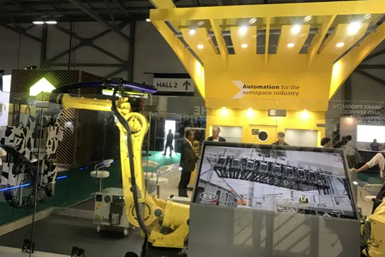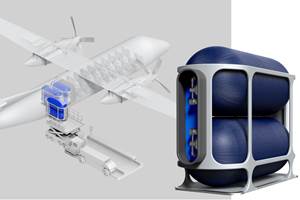2022 Farnborough International Air Show highlights
Farnborough, as usual, provided a platform for a variety of announcements in the aerospace, defense and advanced air mobility spaces from companies like GKN Aerospace, Joby, Airbus, Rolls-Royce, Boom Supersonic and others.

Photo Credit: Vertical Aerospace
The biennial Farnborough International Airshow (FIA), a trade exhibition for the aerospace and defense industries, took place this week, July 18-22, 2022, in Farnborough, U.K. This was the first Farnborough show since 2018 and has served as a litmus test for how the post-COVID world is evolving for commercial aerospace, space, defense, sustainability, innovation, future flight and workforce development. Below is an aggregation of some of news announced throughout the show that has relevance to the composites industry.
Urban air mobility U.K. certification
Joby Aviation (Santa Cruz, Calif., U.S.), announced that it has formally applied for its electric vertical takeoff and landing (eVTOL) aircraft design to be certified for use in the U.K. While Joby is currently pursuing type certification (TC) for its aircraft with the U.S. Federal Aviation Administration (FAA) and expects the U.S. to be its first operating market, this application will enable Joby’s U.S.-based certification to be concurrently validated by the U.K.’s Civil Aviation Authority (CAA), accelerating the company’s path to market in the U.K. Joby is believed to be the first eVTOL company to apply for foreign validation of its FAA TC.

Photo Credit: Joby Aviation
New variants for VX4 aircraft
Vertical Aerospace (Bristol, U.K.), is partnering with Babcock International (London, U.K.), an aerospace, defense and security company, to explore new applications for its VX4 eVTOL aircraft. Capable of traveling distances of more than 100 miles, achieving top of speeds of 200+ miles per hour with low noise, the aircraft has reportedly proven demand in the passenger transportation markets from established airline customers including Virgin Atlantic, aircraft lessors such as Avolon (Dublin, Ireland), and helicopter and tourism operators such as Bristow (Dyce, U.K.) and Iberojet (Palma, Spain).
Additional applications to be explored by Vertical Aerospace and Babcock International include aerial EMS and cargo transportation. Both companies will also work to develop modular maintenance, repair and overhaul (MRO) capabilities to enable cost-effective maintenance of the aircraft in remote and challenging environments and maximize availability.
Air taxi regulations
The European Union Aviation Safety Agency (EASA) announced publication of proposed rules for the operation of air taxis in cities, the first comprehensive proposal for such regulations to be issued worldwide. The agency notes that “the proposed new regulatory framework is open to public consultation until September 30, 2022, and cover the technical domains of airworthiness, air operations, flight crew licensing and rules of the air,” complementing existing EU regulatory material for operations of unmanned aircraft systems (UAS), the unmanned traffic management system known in Europe as U-space and the certification of aircraft capable of VTOL, as well as EASA guidance on the design of vertiports. It also is said to address general societal concerns and the expectations of EU citizens with respect to safety, security, privacy, environment and noise. Certain future developments (e.g., VTOL-capable aircraft without a human pilot on board) are not yet covered in this proposal, but will be addressed by EASA with separate proposals when needed and in line with technological progress.
Read the full article here.
Supersonic flight updates

Overture aircraft rendering. Photo Credit: Boom Supersonic
Boom Supersonic (Denver, Colo., U.S.) revealed at Farnborough the latest design iteration of the company’s Overture aircraft. Carrying 65-80 passengers at twice the speed of today’s airliners and running on 100% sustainable aviation fuel (SAF), Overture will fly Mach 1.7 over water with a range of 4,250 nautical miles. Features of the modified design include four engines to reduce noise and operating costs, a fuselage that is larger in diameter at the front than the back to increase efficiency, gull wings to improve handling and carbon fiber construction to reduce weight and meet design contour requirements.
Additionally, Boom Supersonic announced that it will begin outfitting a new 70,000-square-foot hardware ground test facility in Centennial, Colo., to house its first full-scale Overture testing model and flight deck simulators. Earlier this year, Boom announced its selection of the Piedmont Triad area in North Carolina, U.S., for its first Overture Superfactory and remains on track to begin production in 2024. Finally, Boom reported a new partnering agreement with Northrop Grumman to develop special-mission variants of Overture.
Wing of Tomorrow prototype assembly completed
Airbus (Tolouse, France) announced at the 2022 Farnborough International Airshow that its transnational R&T program, Wing of Tomorrow (WOT), has successfully delivered a first full-size wing demonstrator that will help mature next-generation wing technologies. The completion of the first of three fully composite wing demonstrators marks the integration of more than 100 component and manufacturing technologies that include an all-new industrial assembly system, and which have helped validate key automation targets. The wing includes many applications of innovative composites M&P, including thermoplastic ribs, an OOA VBO rear spar, infused skins, newly designed leading edge spars and more. The new build philosophy on WOT also eradicates in-tank working and enables manual and automated assembly to be smoothly integrated into an optimized industrial system.
Full announcement can be found here.
eVTOL cabin concept unveiled
Supernal (Washington, D.C., U.S.) revealed its initial electric vertical takeoff and landing (eVTOL) vehicle cabin concept at Farnborough International Airshow, providing the first look at how Hyundai Motor Group (Seoul, South Korea) is integrating automotive capabilities to develop the advanced air mobility (AAM) market.
Supernal’s five-seat cabin concept design embodies biomimicry — a butterfly in this case — and the company’s pillars of safety, human-centered design and environmental responsibility. With sustainability as a priority, the cabin concept incorporates materials such as advanced recyclable carbon fiber-reinforced thermoplastic (CFRTP), durable plant-based leather, recycled plastic fabric and responsibly sourced woods. Supernal hopes to certify its eVTOL vehicle for commercial use in the U.S. starting in 2028, with the E.U. and U.K. following soon after. Read the full announcement here.
New iteration of FibreFORM technology unveiled
At the Farnborough Air Show, Loop Technology (Dorchester, U.K.) unveiled the new iteration of FibreFORM, the company’s composite ply pick-and-place tool used to automate the layup of large-scale preforms. The new design includes a significant reduction in energy consumption to improve its accessibility.

Photo Credit: Loop Technology
At the show, the arctic-camouflage-wrapped module of FibreFORM was mounted on a Fanuc R-2000iC/210F robot. The pair drew the attention of aerospace manufacturers and suppliers from across the world. Visitors learned how FibreFORM could pick up a large ply and place it into a 3D mold tool to build a preform stack. They also watched a demonstration of its dexterity as it transformed into concave and convex shapes, and its flexibility when coupled with six-axis motion. The previous iteration was installed at the National Composites Centre (Bristol, U.K.) as part of its Ultra High Rate Deposition Cell, according to the company.
Related Content
Paris Air Show 2023 highlights
The Paris Air Show, one of the largest aerospace trade shows in the world, returned for the first time since 2019 and proved that the global aviation industry industry is very much alive and kicking.
Read MoreWe're going to need a lot of propeller blades
As advanced air mobility expands and annual shipsets get into the thousands, the demand for composite propeller blades is expected to skyrocket. What are the implications for the composites supply chain?
Read MoreJEC World 2022, Part 3: Emphasizing emerging markets, thermoplastics and carbon fiber
CW editor-in-chief Jeff Sloan identifies companies exhibiting at JEC World 2022 that are advancing both materials and technologies for the growing AAM, hydrogen, automotive and sustainability markets.
Read MoreCarbon fiber in pressure vessels for hydrogen
The emerging H2 economy drives tank development for aircraft, ships and gas transport.
Read MoreRead Next
From the CW Archives: The tale of the thermoplastic cryotank
In 2006, guest columnist Bob Hartunian related the story of his efforts two decades prior, while at McDonnell Douglas, to develop a thermoplastic composite crytank for hydrogen storage. He learned a lot of lessons.
Read MoreCW’s 2024 Top Shops survey offers new approach to benchmarking
Respondents that complete the survey by April 30, 2024, have the chance to be recognized as an honoree.
Read MoreComposites end markets: Energy (2024)
Composites are used widely in oil/gas, wind and other renewable energy applications. Despite market challenges, growth potential and innovation for composites continue.
Read More























.jpg;maxWidth=300;quality=90)









